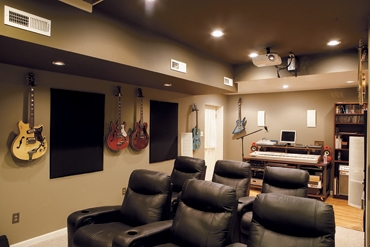The House That Jim Built, Part 3 Page 2

AND THEN THINGS TURNED UGLY
Everything seemed to be going well when I called in Hudson Valley Home Media to spec out the basement's low-voltage prewire, which I assumed would be an easy job since the central demarc panel was in the adjacent basement area. But when Barry discovered that my theater would run sideways across the width of the room, he laughed and said the room's dimensions wouldn't allow for a screen bigger than 80 inches. "You might as well forget the projector and just get a 65-inch plasma," he said.
Since there was no way I was going to have a home theater without a projector, the idea of dividing the space evenly between the theater and the recording studio became history. Instead, there'd be one multi-use room with a projection screen at one end and the studio at the other. But then Barry pointed out another problem: For the screen to be centered on the far wall, it would have to fit under the soffit on the right side of the room. That would limit the screen's size, since it had to be a minimum height off the floor. Had I known that the screen was going on that wall, I would have run the ductwork straight down the wall instead of straight out into the room.
Proving that misery loves company, there was yet another issue: I had sheetrocked the ceiling rather than install a dropped acoustic-tile ceiling. Unfortunately, when the rest of the house was wired, I had Barry run the low-voltage cables under the basement ceiling joists instead of through them, since I thought they'd be hidden. That meant all the wires for the family room (which is just above the home theater) would now have to be ripped out and re-run through the joists. Fortunately, Barry's team was able to divert the upstairs RG6 and Cat5e cables to wire the basement equipment rack, and then run new wires through the joists for the upstairs gear.
After Barry's team was done, I ran audiophile-grade 12-gauge speaker wire through the walls to all the speaker locations, and pulled RG6 cable through conduit behind one wall to the subwoofer locations. (RG6 is better for long subwoofer runs.) Then I rushed to insulate all the walls, the HVAC/equipment room, and the soffits with kraft-faced fiberglass insulation before the drywallers arrived. After the room was sheetrocked and sanded, I painted the walls and ceiling, had a carpet installed in the theater area (reserving some extra carpeting to cover a planned seating riser), and then laid a Pergo-style wood floor in the studio section of the room, which I wanted to sound a bit livelier for recording purposes.
 |
| The gear rack, which has plenty of access from the rear, was assembled from two Raxxess studio racks. A Bellari tube preamp for the red Pro-Ject turntable, mounted on a sliding rack shelf, is located on a small shelf inside the room. |
I seriously considered installing a fiber-optic star ceiling panel system from a company called iSky, but ultimately wasn't sure how it would look given the two soffits. Instead, I installed acoustic ceiling tiles, which resemble tin panels, directly on the drywall in a framed section of the ceiling over the theater, and then painted them with bronze-colored metalflake paint. The tiles add a nice design element to the room, and help provide additional sound insulation for the upstairs family room.
Once the walls were done, I ordered speaker-terminal wall plates that can handle spade connectors from PartsExpress (a company that saved my butt several times by overnight-shipping parts and cables I'd neglected or forgotten to order) for the front three speakers. The RG6 cables for the subs terminate at a coaxial wall plate with an RF-to-RCA-adapter.
GEARING UP
Since the mistakes had propelled me way over my construction and wiring budgets - and I still had to buy a projector and screen - my goal was to use as much of my existing equipment as I could. But rapid technological changes in the video world had rendered a lot of my high-end gear nearly obsolete. For example, neither of my home theater preamp/processors - a Krell Showcase and a McIntosh MX132, superb units both - have HDMI inputs or outputs, or support for the new lossless audio formats. I also wanted a processor that could do a good job deinterlacing and upscaling standard DVDs. That search led me to Integra's DTC-9.8, a 7.1-channel preamp/processor with four HDMI inputs, built-in decoding for both Dolby TrueHD and DTS-HD Master Audio, HD Radio, and Silicon Optix's HQV Reon-VX video-processing chip..
All the signal sources in my rack - which I made by joining two Raxxess 20-space economy studio racks and mounting them between wall studs - go through the Integra. The current lineup includes an LG BH200 Blu-ray Disc/HD DVD player; a Pioneer Elite DV-09 DVD player, which serves as the main playback device for CDs; a Pioneer DV-563A universal DVD player, which I use for SACDs and DVD-Audio discs; and a black DirecTV HR21-200 HD DVR. A recent acquisition - a Ferrari-red Project Debut III turntable - is situated on a sliding Raxxess shelf, mated to a matching Bellari tube phono preamp. Fortunately, power amps never fall out of favor, and I was able to use my Krell Showcase and B&K 7260 Reference multichannel amps to power the system. All the gear is connected to a Furman Elite 15 PF i power conditioner/surge protector.
- Log in or register to post comments



































































